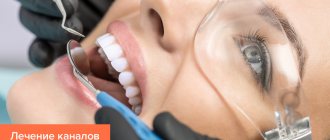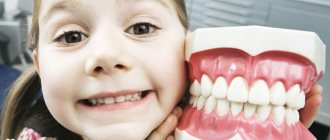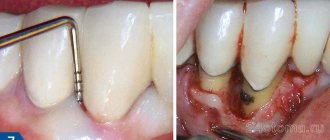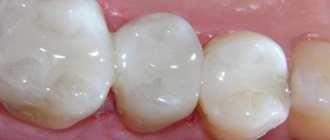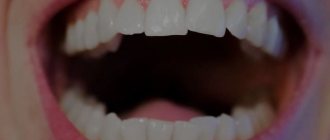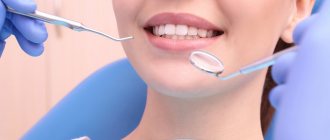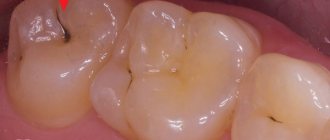Caries of the front teeth can lead to chipped enamel, severe pain and even a change in diction. In addition, it creates an aesthetic problem, as it makes the smile unattractive. If left untreated, it spreads to adjacent incisors. We will tell you why caries occurs on the front surface of the tooth, how it manifests itself and how to get rid of it.
The front teeth of a person are called 8 incisors and 4 canines, which fall into the smile zone. Any enamel damage in this area looks unaesthetic. In this case, most often the front teeth are affected by caries - a slow-moving pathological destruction of the hard tissues of the tooth (dentine).
In this article
- Causes of caries on the front teeth
- What caries looks like in the front teeth: symptoms
- Types of caries in front teeth
- Types of caries of incisors according to the form of occurrence
- Types by localization of the pathological process
- Black classification
- Diagnostics
- How to treat caries on the front teeth
- How to treat caries at an early stage
- Treatment for medium and deep stages of caries
- Treatment for severe crown lesions
- Treatment of caries of anterior teeth in children
- Complications
- Prevention of caries
The most common cause of this disease is the proliferation of cariogenic microbes. However, there are other factors leading to its development. Let us tell you why caries of the front teeth begins.
Causes of caries on the front teeth
Doctors distinguish two groups of caries factors - local and general. The first include:
- Poor oral hygiene. Lack of dental care or improper brushing leads to the formation of deposits on the enamel and gums. Over time, they accumulate and bacteria begin to multiply in them, which destroy hard tissue.
- Disruption of the salivary glands. Saliva washes germs off your teeth and neutralizes toxins created by germs in your mouth. If it is produced in insufficient quantities, the number of microorganisms increases, and the amount of their metabolic products also increases. As a result, they cause decay and damage to dentin.
- Anatomical features of the jaw and tooth structure. Their crowding leads to the rapid accumulation of plaque, as more places appear in the oral cavity that are difficult for toothbrushes to reach. An incorrect bite can also lead to tooth decay. In some cases, it becomes a consequence of carious lesions.
- Poor nutrition. The bacteria that cause tooth decay feed on carbohydrates. The more a person eats sweets, the higher the likelihood of pathology.
There are also common factors for the development of caries on the front teeth. Among them:
- Biological: heart and vascular diseases, endocrine pathologies, gastrointestinal problems, medications, weak immunity, genetic predisposition, stress.
- Environmental factors: poor ecology, unfavorable climate, drinking soft water devoid of minerals, lack of sunlight.
- Social: work in hazardous conditions, childhood, etc.
In children, caries occurs more often than in adults, in women - more often than in men, in white people - more often than in representatives of the Negroid race. This disease affects the front teeth more often than molars and premolars. This is due to the fact that the enamel on them is thinner than on chewing teeth, so they are more vulnerable to external factors and microbes. Let us tell you how caries manifests itself on the front teeth.
Why does cervical caries appear and develop?
As we wrote above, the tooth enamel in the cervical area is quite thin and vulnerable, in addition, the cervical area of the tooth is quite difficult to properly clean from plaque during cleaning. And the remaining plaque is a favorable environment for the proliferation of different types of pathogenic microorganisms, including carious bacteria.
The vital activity of these bacteria leads to the active formation of lactic acid, which destroys tooth enamel and, as a result, cervical caries occurs. Also, the occurrence of cervical caries can be caused by the abuse of abrasive pastes, taking certain medications, and chronic general diseases of the body. An unbalanced diet can also be a factor provoking the development of cervical caries, therefore, even while following diets that are so fashionable these days, it is important to ensure that the body receives all the necessary vitamins and minerals!
What caries looks like in the front teeth: symptoms
Symptoms depend on the degree and type of disease. The main symptoms of incisor caries:
- sensitivity of the front teeth: accompanied by pain when the enamel is exposed to sour, sweet, hot or cold foods;
- the appearance of dark or white spots on the enamel, which indicate areas of demineralization;
- visible destruction of crowns, chips, cracks, formation of cavities that gradually increase;
- inflammation of the internal tissues of the pulp (pulpitis) or the ligaments holding the tooth in the alveolus (periodontitis);
- putrid odor from the mouth, which can only be hidden with the help of mint toothpaste or chewing gum.
At the initial stage, the disease may not manifest itself, but if any of the listed signs occur, you should consult a dentist. There are also specific symptoms characteristic of one form or another of caries. Let's look at the types of this disease.
Types of caries in front teeth
Caries on the incisors is classified on several grounds. So, according to the degree of development it is:
- Beginners. An unnatural white spot can be seen on the surface of the enamel, which is a consequence of the leaching of minerals from this area of the tooth. At this stage, caries is treated with the help of remineralization - restoring the balance of minerals in the enamel structure.
- Superficial. If the initial stage of the disease is left unattended, the white spot begins to darken and becomes rough to the touch. There is increased sensitivity to sweet and sour foods, and to cold.
- Average Dark yellow or brown cavities form on the tooth. Their sizes and shapes may vary. Lack of treatment leads to the growth of pathological areas.
- Deep. The last stage of caries, which is accompanied by the destruction of hard tissues. The tooth may break into several pieces. The dark spot spreads over the entire surface of the enamel, penetrating into the dentin, so the painful sensations intensify. A tooth can hurt just like that, without being affected by food or drinks.
It is advisable to get rid of caries on the front teeth at the initial or superficial stage, because it progresses quickly in this area of the jaw.
Features of restoration
It is important not only to correct the appearance of the tooth, but also to cure the disease. At an early stage, when white or brownish spots just appear on the surface, sanding or bleaching can be done. But you don’t need to do this at home, the doctor will make the procedure much more effective and protect against complications. He can use professional grinding discs and polishers. Severe cases require the use of a drill.
Air abrasive is a more gentle processing method. It involves spraying a special substance that affects dental tissue. But this technique is not effective in all cases and is very expensive. Some clinics use laser; this is a simpler method, but requires more investment. Moreover, its effectiveness has not been proven one hundred percent; there is still debate among experts about it.
Types of caries of incisors according to the form of occurrence
According to the form of occurrence, the following types of caries are distinguished:
- Acute: develops rapidly, in 10-14 days the disease passes through the initial, superficial and middle stages.
- Chronic: occurs slowly, gradually destroying the enamel and turning it dark. Caries takes on this form when the main factors that provoked the disease no longer affect the body, but no treatment was provided.
- Multiple: caries occurs in several places on the same tooth or on different teeth.
- Secondary: formed under an installed filling.
In this case, secondary or multiple can occur in both acute and chronic forms. For some people, caries practically does not go away, but does not bother them with pain or other symptoms. However, their teeth slowly deteriorate, increasing the risk of their removal.
Options for solving the problem
To ensure that a noticeable front tooth does not darken at all after treatment, particularly careful canal filling is important. In this case, only materials are used that preserve the natural color of the teeth.
Light seals
The filling material hardens under the influence of a special polymerizing lamp. It allows you to repeat in detail the anatomical parameters of the tooth. Provides reliable, durable filling.
Ceramic veneers
The surface of the tooth with ceramic veneers is smooth, even, without the slightest traces of treatment or restoration. Ceramics retains color, shape, is extremely strong and durable.
The original shape of pulpless teeth is often restored using ceramic crowns. They are securely attached to the stump and look as inconspicuous as possible.
Types by localization of the pathological process
Caries of the anterior teeth is localized:
- Cervical: caries begins near the neck in the gum area or under it. The main reason for this is poor oral hygiene.
- Interdental: carious lesion is observed between two incisors. Often this type of disease occurs with a small gap between them. This is where food debris gets stuck, which decomposes and causes damage to the enamel.
- Fissure: affects the grooves on the tips of the teeth. Typically, this form of the disease develops on molars, rather than on incisors and canines.
Most often, caries of the front teeth is interdental. If left untreated, the stain spreads to both incisors. If the disease starts, a hole will form between the teeth, which will be difficult to repair. At any moment, enamel and hard tissues can split into several parts.
Elimination of the disease
There are several options for treating caries; the choice of one or the other depends on the stage of its development and the financial capabilities of the patient.
Installation of veneers
Recently, this method has become very popular, especially among show business stars. It is good because with the help of special ceramic or polymer crowns you can hide all defects (shape, shade, etc.). But to install the plates, you need to grind off the dental tissue by about half and drill out all the affected areas. The custom-made veneer is then bonded using a non-toxic substance.
With high-quality installation, it can remain unchanged for up to 10-15 years.
The price of such a procedure at Dentic is about 30,000 rubles per tooth.
Crowns
They are used when the disease progresses to a deep stage and covers both sides of the incisor. They are usually made of metal and ceramics: these materials are very durable and are relatively cheap: 20 thousand rubles. But they also have a drawback: it is very difficult to choose a shade that will not stand out in the teeth. To avoid big differences, it is necessary to choose crowns made entirely of ceramic or zirconium.
Implantation
When caries destroys tissue down to the root, more serious measures must be taken. The diseased area is removed, and in its place an implant is implanted into the jaw. It is a strong rod that will hold the crown. Nowadays they make it very natural and aesthetic. The cost at Dentic starts from 30,000 rubles.
Prosthetics
There are cases when installing an implant becomes impossible, for example, when there is a risk that it will not take root, or the gums are not thick enough. Then special zirconium or ceramic prostheses are created, which are attached to adjacent units.
Treatment of caries between the front teeth with pinning
If only the root of the affected incisor remains intact, then a pin is inserted into it, having been carefully processed beforehand. It is then masked with a temporary crown for about a week while it takes root. Next they set a constant.
Black classification
American dentist Green Black developed his own classification of caries, dividing it into classes:
- 1st class: carious lesions are localized in fissures;
- 2nd class: the pathological focus is localized between the molars;
- 3rd class: caries affects the areas between the incisors and canines;
- 4th class: the disease develops along the edges of the front teeth;
- 5th class: the affected area includes the cervical area;
- 6th grade: caries affects the cutting edges of the front teeth.
During the diagnosis, the doctor determines the degree and type of caries of the front teeth, based on which he selects treatment.
Diagnostics
It is not always possible to detect caries at the initial stage, since it can be localized on the back side of the tooth. Therefore, dentists recommend coming for an oral examination every six months. During diagnosis, the doctor uses a detector staining method. It allows you to distinguish caries from other similar diseases: fluorosis, enamel hypoplasia, tetracycline teeth, etc.
The dentist can also probe the cavity to assess the nerve's response to exposure. If deep caries is suspected, the patient is sent for an x-ray of the jaw. After the examination, the type of treatment is determined.
Experts' opinion
The effectiveness of ASEPTA products has been repeatedly clinically proven. For example, according to research conducted at the Ryazan State Medical University named after Academician I.P. Pavlova of the Ministry of Health and Social Development of the Russian Federation (GBOU VPO RyazSMU Ministry of Health and Social Development of Russia), during the use of Asepta line products, a decrease in complaints of discomfort in patients is noted. Upon examination, a decrease in hyperemia and swelling of the gums was noted, but bleeding persisted upon probing.
Sources:
- Clinical experience in using the Asepta series of products Fuchs Elena Ivanovna Assistant of the Department of Therapeutic and Pediatric Dentistry State Budgetary Educational Institution of Higher Professional Education Ryazan State Medical University named after Academician I.P. Pavlova of the Ministry of Health and Social Development of the Russian Federation (GBOU VPO RyazSMU Ministry of Health and Social Development of Russia)
- Report on clinical trials to determine/confirm the preventive properties of commercially produced personal oral hygiene products: mouth rinse "ASEPTA PARODONTAL" - Solution for irrigator." Doctor of Medical Sciences Professor, Honored Doctor of the Russian Federation, Head. Department of Preventive Dentistry S.B. Ulitovsky, doctor-researcher A.A. Leontiev First St. Petersburg State Medical University named after academician I.P. Pavlova, Department of Preventive Dentistry.
- Report on determining/confirming the preventive properties of toothpaste “ASEPTA PLUS” GENTLE WHITENING” Author: doctor-researcher A.A. Leontyev, head Department of Preventive Dentistry, Doctor of Medical Sciences, Professor S.B. Ulitovsky First St. Petersburg State Medical University named after. acad. I.P. Pavlova, Department of Preventive Dentistry
Treatment for medium and deep stages of caries
Medium and deep caries are already serious lesions that cannot be eliminated with fluoride and calcium. It is necessary to drill into the tooth, clearing it of germs and dead tissue, in order to install a filling. In most cases, the procedure is performed under local anesthesia.
We list the stages of treatment:
- removal of caries-affected areas with a drill;
- disinfection of the cleaned surface;
- drying the cavity with an air stream;
- installation of a dental dam;
- layer-by-layer application of filling composition;
- grinding and polishing of the filling.
At the final stage, the patient has a paper plate inserted between the teeth to evaluate the bite. If there is any discomfort, you must inform the doctor, he will continue grinding and polishing.
Treatment methods
Modern dentistry offers a wide range of effective methods for treating caries. Depending on the stage of development of the disease, the presence of complications and other factors, gentle (not associated with the use of a drill) or filling methods can be used.
For the initial stages of caries, in which the dentin is not affected, the following treatment procedures are suitable:
- laser treatment and removal of affected tissue;
- ozone therapy, which eliminates harmful bacteria;
- Icon method (treatment with “liquid filling”);
- air abrasive treatment of the dental surface.
The key advantage of such methods is that they are non-traumatic and pain-free. The integrity of the tooth enamel is not compromised during this treatment, and the dentist manages to avoid filling. But only those types of caries that have been diagnosed in their infancy can be treated in this way.
For more advanced stages of the disease, options associated with dental fillings are used.
Basic procedures to cure caries:
- channel cleaning;
- tooth filling;
- installation of veneers;
- pin restoration;
- dental crowns, dentures and implants.
Any treatment of caries in the middle and advanced stages begins with cleansing and treatment of the dental canals. This is a complex and painstaking procedure that requires delicate and careful work of a specialist.
The dentist’s main task during cleaning is to ensure complete removal of even the smallest particles of carious tissue. If this is not done, and at least a small area of rot remains in the dental canal, then over time the disease will relapse and caries will return. The danger of this situation is that with recurrent caries, inflammation begins directly in the depths of the tooth, affecting the tissue from the inside.
After the canals are thoroughly cleaned and disinfected, the dentist chooses the further method of treatment based on the actual condition of the diseased tooth.
If the damage is minor, filling and restoration of the missing part of the tooth is performed. Much attention is paid to careful grinding of the surface and scrupulous selection of the shade of the filling material. On the front teeth, it is especially important that the restoration site does not stand out against the background of the rest of the tooth enamel. There are special shade cards that allow you to choose the perfect filling color.
Veneers are used as an alternative to conventional restoration for caries. These are special onlays that not only improve the appearance of the tooth after treatment procedures, but also protect it from damage in the future.
If the course of caries has gone too far, and there is deep damage to the dentin, there is a need for prosthetics, the manufacture of dental crowns or implants. A softer option is to install pins. The pin is used when the outer part of the tooth is destroyed, but the root is in good condition.
Treatment for severe crown lesions
If caries affects more than 50% of the incisor or canine tooth, it will not be possible to install a filling. After removing the carious areas, the patient is sent to an orthopedist for installation of an orthodontic structure: a bridge, crown, veneer or lumineer. They allow you to hide a cosmetic defect that appears after an illness.
If the tooth is completely destroyed by caries, but the root remains, the doctor installs a pin and a crown. If a tooth is completely lost, an implant will be required. This is one of the most expensive dental procedures.
Treatment of caries of anterior teeth in children
Treatment of caries in children and adults follows the same stages. However, children are more difficult to treat because they are afraid of doctors. Parents must properly prepare their child for a visit to the doctor. To relieve fear, experienced dentists turn treatment into a game.
Some parents believe that there is no need to treat baby teeth, since they will fall out anyway. However, this opinion is wrong. Caries can spread to soft tissues and ligaments, which subsequently affects the condition of the molar.
Is it possible to cure cervical caries on your own?
Traditional medicine is extremely popular these days, so new recipes for treating various diseases at home regularly appear on the Internet, including supposedly effective methods for treating cervical caries. But, alas, dental caries is not a disease that can be cured without consulting a doctor. No matter how powerful natural antiseptics are, they will not stop the process of tooth destruction under the influence of carious bacteria, especially in cases where cervical caries has developed to a medium or deep stage. At these stages of caries development, it is important to remove all affected tissues and qualitatively treat the tooth with medications, put a filling on it in order to prevent further development of cervical caries. Naturally, all these manipulations can only be carried out in a clinical setting.
And one more important point that you need to know and remember: folk remedies cannot be used uncontrollably. You may be allergic to them, and the use of caustic solutions and mixtures can lead to burns of the soft tissues of the mouth and other sad and serious consequences. As a result, instead of getting rid of caries, you can “earn” yourself pulpitis, poisoning, severe allergies and the need for complex and expensive treatment!
The only thing that can and should be done at home is to prevent the development of cervical caries, and below we will tell you how to do this correctly.
Prevention of caries
It is better to try to prevent tooth decay than to treat it. Adhere to the following rules:
- Brush your teeth twice a day. However, this must be done correctly. Check with your doctor about the algorithm for cleaning your mouth with a toothbrush.
- Use additional oral hygiene products: dental floss, rinses, irrigators.
- Change your toothbrush (or brush head if you use an electric model) every 3 months.
- Protect your teeth from mechanical damage. When playing sports, wear a mouth guard, do not chew nuts in the shell, etc.
- Reduce your consumption of sugary foods; Try not to eat too hot or very cold foods.
- Make an appointment with your dentist every six months for a preventive examination, even if there are no complaints.
You can avoid caries even if you have a genetic predisposition to it. You just need to monitor your dental health and not neglect the above rules. Any symptom - bad breath, pain, tooth sensitivity, bleeding gums - should be a reason for an emergency visit to the doctor.
Features of installing a filling for cervical caries
With cervical caries, the affected area of the tooth is located as close as possible to the edge of the gum, and therefore saliva, blood, and moisture, which are present in abundance in the oral cavity, can easily enter the treatment area. To eliminate this, a rubber dam is used, but you also need to choose and place the filling material correctly. To do this, the doctor leading the treatment of cervical caries must have both experience and relevant knowledge! The slightest mistakes when processing the tooth and installing the filling can lead to the loss of the restoration, as well as to the recurrence of cervical caries already under the installed filling.
To fill a tooth after treating cervical caries, special heavy-duty composite materials that are resistant to moisture and other external factors are used. The aesthetics of these materials are also excellent, because cervical caries often develops in the area of the front teeth, which are clearly visible when smiling.
USEFUL TO KNOW: Do you want cervical caries to be treated efficiently, and for the installed filling to serve you for as long as possible? Choose the right dental clinic for caries treatment! Remember that a good clinic does not offer its patients low prices, but modern equipment, first-class materials, innovative technologies, and experienced and qualified specialists work in such dentistry!
